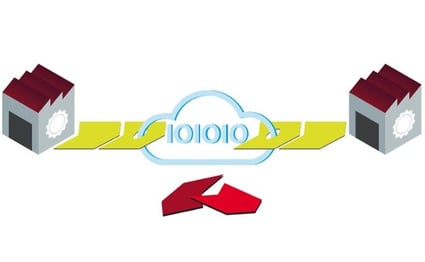Is Your Supply Chain Ready to Go Digital?
Brian Hoey - August 07, 2018

 Pop quiz: when’s the last time, either in a personal or a professional capacity, that you made a purchase from a business that did not have a website? Sure, you may have wandered into a charming little brick and mortar store and made an impulse purchase, or maybe you did a bit of antiquing, but I’ll bet that for most major purchases in recent memory you would have been loath to place your trust in a business with no online presence. This is, of course, with good reason. A web presence allows you to read product reviews from other customers, gives you the resources to make more informed purchasing decisions, and lends legitimacy to their enterprise. Once you’ve experienced the added conveniences of a digital business, it’s unlikely you’ll be eager to go back to the old way of doing things.
Pop quiz: when’s the last time, either in a personal or a professional capacity, that you made a purchase from a business that did not have a website? Sure, you may have wandered into a charming little brick and mortar store and made an impulse purchase, or maybe you did a bit of antiquing, but I’ll bet that for most major purchases in recent memory you would have been loath to place your trust in a business with no online presence. This is, of course, with good reason. A web presence allows you to read product reviews from other customers, gives you the resources to make more informed purchasing decisions, and lends legitimacy to their enterprise. Once you’ve experienced the added conveniences of a digital business, it’s unlikely you’ll be eager to go back to the old way of doing things.
As recent trends are showing, this preference for the digital applies to supply chains just as much as it does to commerce, especially for such complex, variant-rich industries as automotive manufacturing. Stakeholders all along the value stream have a distinct preference for digitized supply chains, owing to the increased transparency and responsiveness that they can provide. Soon, supply chain managers will think of non-digital supply chains the way that most consumers think of non-digital businesses. Is your business ready for that challenge?
Why Digitization?
It’s possible, of course, that as you read this you are asking yourself a slightly different question: why should my supply chain go digital? All glibness aside, the reason that digital supply chains are poised to become the norm rather than the exception is that there is considerable value to be had from digitizing processes that used to be done manually. Inventory management, for instance, has the potential to be radically improved in a digital environment. Digital records of stock movements can be made highly visible, and thus ripe for optimization, whereas physical records can make it difficult for planners to access the information they need, inevitably resulting in a non-optimal use of valuable storage space (to say nothing of outages or bottlenecks). By the same token, transport routing, capacity planning, and production scheduling all thrive in a digital environment in which resources can be easily tracked and plans can be easily shared. The alternative is an environment prone to decision-making silos and low visibility. A digital supply chain is one in which every touchpoint on the value chain has visibility into every other touchpoint, leading to smoother supply chain management overall.
In addition to creating an environment that prioritizes openness, collaboration, and easy tracking of resources. Digitization also lays the groundwork for the integration of more sophisticated technologies. Things like machine learning, advanced analytics, real-time information, and Industry 4.0 all require a baseline of digitization. Just as visibility and transparency are quickly becoming important value added propositions for customers, these new technologies that build upon digital frameworks can help to reduce breakdowns and bottlenecks in such a way as to add convenience and value for your supply chain partners. If you're a supply chain manager, digitization is a kind of stepping stone to future adaptations. Without it, how will your supply chain remain responsive and adaptable in the future?
Obstacles to Digitization
As you’re (hopefully) getting a sense of the ways in which a digital infrastructure can be crucial to the modern supply chain, you’re probably also beginning to understand the challenges that stand in the way of businesses hoping to digitize their supply chains. Just as digitization produces added visibility, for instance, it also depends on visibility in order to create cohesive, interoperable systems that are capable of working in harmony with one another. That means that businesses need to avoid or root out information silos and Shadow IT (software or applications that don’t have the explicit buy-in of either leadership or information technology teams) in their existing infrastructure.
In addition to decreasing the availability of mission critical information, silos make it difficult to gain cohesion with an organization and get employees on the same page. As such, one of the most significant hurdles to digitization gaining buy-in from various corners of your operation, from planners to supply chain managers to members of the C-suite. Think about it: if various factions within a company are unwilling or unable to adapt to these new realities, the project of digitization will necessarily be left incomplete. This means that a task like, say, transport management, which relies on upstream insights along the value chain, would be just as mired in obscurity as it would in a supply chain with no digital touchpoints, owing to the impossibility of putting any given number or datum into its proper context.
This logic applies not just within your organization, but also with regard to your partners and suppliers. If you’re going to gain maximum value from digitizing processes, it’s crucial that these processes be poised to integrate with both other supply chain functions within your company and with external elements, from shippers or freight forwarders to third party hubs or warehouses. Thus, another crucial step to digital readiness is to partner with businesses that can ensure future digital integration. For many businesses, this last obstacle can require a great deal of rethinking and restructuring of the way that business is conducted. Businesses that boast digital partners, minimal silos, and strong team cohesion, on the other hand, are more likely to meet the challenges of increasingly complex automotive and manufacturing fields.
LATEST POSTS
- Understand Circular Economy in The Manufacturing Industry
- How Can Industry 4.0 IT Integration Be Achieved Smoothly?
- The Significance of Order Sequencing in Discrete Manufacturing
- How to improve your Supply Chain Management: The Power of Control Towers
- Optimizing Human Resource Scheduling in Manufacturing: A Technological Approach



